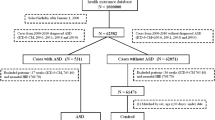Abstract
Birth orders and maternal ages of the 113 autistic patients were compared with those of the general population. An excess of mothers aged 35 or older was observed in the autistic group, though the mean maternal age for the whole group was very similar to those of the general population. A deviation from average in birth order was observed in autistics. Significantly more autistics were products of at-risk pregnancies (defined as either first, fourth, or later born, or born to mothers aged 30 or older) than the base population. The results suggest that at least some environmental factors are involved in the causation of autism. The findings support the idea that a multifactorial mechanism is responsible for some or all of the cases.
Similar content being viewed by others
References
August, G., Stewart, M. A., & Tsai, L. The incidence of cognitive disabilities in the siblings of autistic children.British Journal of Psychiatry, 1981,138, 416–422.
Bakan, P. Handedness and birth order.Nature, 1971,229, 195.
Bakan, P., Dibb, G., & Reed, P. Handedness and birth stress.Neuropsychologia, 1973,11, 363–366.
Barry, H. Incidence of advanced maternal age in mothers of one thousand state hospital patients.A.M.A. Archives of Neurology and Psychiatry, 1945,54, 186–191.
DeMyer, M. K.Parents and Children In Autism. Washington, D.C.: V. H. Winston & Sons, 1979.
DeMyer, M. K., Barton, S., Allen, J., & Steele, R. Prognosis in autism: A follow-up study.Journal of Autism and Childhood Schizophrenia, 1973,3, 199–246.
DeMyer, M. K., Barton, S., Alpern, G. D., Kimberlin, C., Allen, J., Yang, E., & Steele, R. The measured intelligence of autistic children: A follow-up study.Journal of Autism and Childhood Schizophrenia, 1974,4, 42–60.
Deykin, E. Y., & McMahon, B. Pregnancy, delivery, and neonatal complications among autistic children.American Journal of Diseased Children, 1980,134, 860–864.
Finnegan, J. A., & Quarrington, B. Pre-, peri and neonatal factors and infantile autism.Journal of Child Psychology and Psychiatry, 1979,20 (2), 119–128.
Folstein, S., & Rutter, M. Infantile autism: A genetic study of 21 twin pairs.Journal of Child Psychology and Psychiatry, 1977,18, 297–321.
Gillberg, C. Maternal age and infantile autism.Journal of Autism and Developmental Disorders, 1980,10, 293–297.
Greenwood, M., & Yule, G. U. On the determination of size of family and of the distribution of characters in order of birth.Journal of Royal Statistical Society, 1914,77, 179–197.
Iowa State Department of Health.Vital Statistics of Iowa. 1966, pp. 117–120.
Iowa State Department of Health.Vital Statistics of Iowa. 1967, pp. 118–119.
Iowa State Department of Health.Vital Statistics of Iowa. 1968, pp. 86–88.
Iowa State Department of Health.Vital Statistics of Iowa. 1969, pp. 122–124.
Iowa State Department of Health.Vital Statistics of Iowa. 1970, pp. 49–57.
Iowa State Department of Health.Vital Statistics of Iowa. 1971, pp. 31–39.
Iowa State Department of Health.Vital Statistics of Iowa. 1972, pp. 32–36.
Iowa State Department of Health.Vital Statistics of Iowa. 1973, pp. 32–36.
Iowa State Department of Health.Vital Statistics of Iowa. 1974, pp. 32–36.
Iowa State Department of Health.Vital Statistics of Iowa. 1975, pp. 50–54.
Iowa State Department of Health.Vital Statistics of Iowa. 1976, pp. 50–54.
Kolvin, I., Humphrey, M., & McNay, A. Studies in the childhood psychoses. VI.Cognitive Factors in Childhood Psychoses, 1971,118, 415–419.
Lotter, V. Epidemiology of autistic conditions in young children. I. Prevalence.Social Psychiatry, 1966, 1, 124–137.
Lowe, L. H., Families of children with early childhood schizophrenia. Selected demographic information.Archives of General Psychiatry, 1966,14, 25–30.
McKeown, T., & Record, R. G. Maternal age and birth order as indices of environmental influence.American Journal of Human Genetics, 1956,8, 8–23.
Penrose, L. S. The relative aetiological importance of birth order and maternal age in mongolism.Proceedings of the Royal Society, 1934, (B),115, 431–443.
Pittfield, M., & Oppenheim, A. Child rearing attitudes of mothers of psychotic children.Journal of Child Psychology and Child Psychiatry, 1964,5, 52–57.
Ritvo, E. R., Cantwell, D., Johnson, E., Clements, M., Benbrook, F., Slagle, S., Kelly, P., & Ritz, M. Social class factors in autism.Journal of Autism and Childhood Schizophrenia, 1971,1, 297–310.
Ritvo, E. R., & Freeman, B. J. Current research on the syndrome of autism: The National Society for Autistic Children's Definition of the syndrome of autism.Journal of American Academy of Child Psychiatry, 1978,17, 565–575.
Rutter, M., & Lockyer, L. A five to fifteen-year-old follow-up study of infantile psychoses. I. Description of sample.British Journal of Psychiatry, 1967,113, 1169–1182.
Schopler, E., Andrews, C. E., & Strupp, K. Do autistic children come from upper middleclass parents?Journal of Autism and Developmental Disorders, 1979,9, 139–152.
Slater, E. The sibs and children of homosexuals. In D. R. Smith & W. M. Davidson (Eds.),Symposium on nuclear sex. London: Heinemann, 1958.
Spence, M. A. Genetic studies. In E. R. Ritvo (Ed.),Autism: Diagnosis, current research and management. New York: Halstead/Wiley, 1976.
Spence, M. A., Simmons, J. Q., Wikler, L., & Brown, N. A. Dermatoglyphics of childhood psychosis: A family study.Human Heredity, 1974,24, 82–87.
Tsai, L., Stewart, M. A., & August, G. Implication of sex differences in the familial transmission of infantile autism.Journal of Autism and Developmental Disorders, 1981,11, 165–173.
Wing, J. K. Diagnosis, epidemiology, aetiology. In J. K. Wing (Ed.),Early childhood autism. Oxford: Pergamon Press, 1966.
Wing, L., & Gould, J. Severe impairments of social interaction and associated abnormalities in children: Epidemiology and classification.Journal of Autism and Developmental Disorders, 1979,9, 11–29.
Author information
Authors and Affiliations
Rights and permissions
About this article
Cite this article
Tsai, L.Y., Stewart, M.A. Etiological implication of maternal age and birth order in infantile autism. J Autism Dev Disord 13, 57–65 (1983). https://doi.org/10.1007/BF01531359
Issue Date:
DOI: https://doi.org/10.1007/BF01531359




